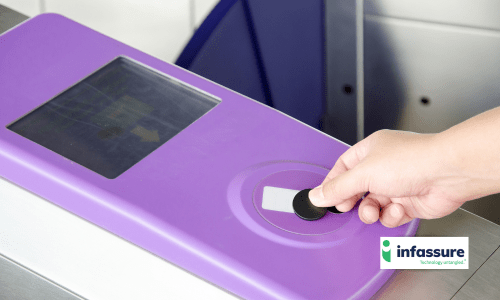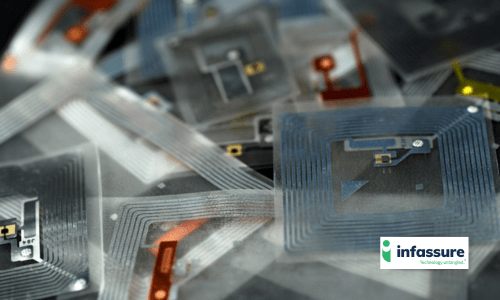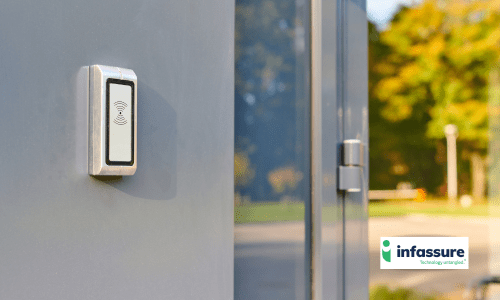RFID access control systems have grown increasingly popular in recent years. Ideal for improving the efficiency of access control systems, these technologies leverage radio frequency identification to allow a user to communicate with a security system, via a card, key fob, or similar tool.
Radio frequency identification (RFID) allows two devices or tools to communicate wirelessly via radio signals. Though the technology isn’t entirely new (it was first developed in the 1970s), the popularity of RFID access control systems has increased in recent years for a few reasons.
These solutions are relatively easy to install and operate and can be configured in various ways to improve the security of your commercial building or environment. Let’s take a closer look at the basics of RFID access control, and how it works.
What is RFID Access Control? The Basics
RFID access control systems are security solutions that leverage the power of radio frequency identification, to manage how people in an environment can access certain doors and locks. Most physical access control systems come with a reader or keypad to allow users to gain access.
Keypads simply require the entry of certain digits to unlock a door, similar to using a PIN number or password. Readers, on the other hand, give users other options, such as NFC and RFID access control. Various forms of RFID technology have been developed for access control and other purposes over the years, however, there are two particularly common options:
- 125 KHz: A slightly older version of RFID technology. This technology is often referred to as “Prox”, short for “Proximity”, because it requires close proximity between an access card and an RFID reader, to convey data back and forth.
- 13.56MHz: A high-frequency version of RFID technology (HF RFID) that operates at a faster data transfer rate and includes options for encryption. This ensures you can protect the data on your access control system from access by unwanted parties.
The Components of an RFID Access Control System
An RFID access control system consists of four main components, designed to work in sequence when providing access rights to a specific location or door:
- An RFID tag: This is a small chip installed in a key card or fob that carries the digital credential information needed to access corresponding RFID door locks.
- The RFID Reader: The RFID access control reader is the system you install next to your secured door or gate. It contains an antenna to receive transmitted data from an RFID tag, and can emit an electromagnetic field to “power” the RFID tag when it’s in close proximity.
- A control panel: Connected to the RFID reader, you’ll have a computer control panel, which is where you can configure access control rules and monitor access.
- Electronic locking mechanisms: RFID readers and control panels connect with an electronic locking system, providing the system with the information required to unlock a door when a person’s identity or credentials are verified.
How Does RFID Access Control Work?
The exact functionality of an RFID access control system can vary depending on the type of technology you choose. In general, these solutions work by using a series of computer servers, readers, and tags to grant access to authorized individuals, in possession of specific credentials.
Each person granted access to a specific locked environment in a building will receive an RFID badge, key card, or fob they can hold up to a reader next to a secured door. The reader then communicates with the card using radio frequency waves, and transmits the data from the card to a computer system.
The access control system examines the credentials to determine whether access is currently allowed based on the rules you’ve already set. It then sends a signal back to the electronic locking mechanism on the door lock to open it when access is granted.
The way users interact with an RFID system will depend on whether you’re using a low-frequency (125Khz) or high- or ultra-high-frequency system. High-frequency access control systems can automatically unlock and grant access to individuals as they move around a building, as long as they have their card or key fob on their person. They may not even have to show a card to a reader. For instance, ultra-high 900MHz RFID locks can detect RFID tags from up to 100 meters away.
What to Look for in an RFID Access Control System
If you decide to use RFID access control in your business, there are various factors you’ll need to consider. Contactless operation and radio frequency recognition will be common on all tools, but you may also want to look for things like:
- Automated locking: An automatic locking system ensures that doors can be re-locked automatically after granting access to an RFID card user. This improves security by ensuring people don’t have to manually lock a door behind them.
- Reprogrammable fobs: Reprogrammable fobs make it easier to update RFID devices for new employees and contractors as they interact with your business. You can program exactly what level of access each user should have into a fob, without having to buy something new.
- Anti-tamper technology: Anti-tamper features might include the ability to program lockdown functions and automated alarms to be engaged if a reader is manipulated by an unauthorized individual.
- Remote management: Many modern access control systems can feature some degree of remote access, such as the option to configure a system using an online portal or application. This gives property owners and security teams control without requiring them to be on-site.
- Time-based automation: RFID lock systems with time-based automation allow you to program doors to lock automatically at certain intervals. You can control these settings remotely, and adjust schedules based on your team’s needs.
Questions? Request a quote today.

RFID vs NFC Access Control
While similar, RFID and NFC have some differences. NFC (Near Field Communication) technology is an evolution of RFID technology. Like RFID systems, NFC systems include cards or tags, readers, and access to computer software.
However, NFC systems have some unique benefits, including that smartphones and watches are equipped with NFC technology and can be used in place of an NFC RFID card. For instance, cutting-edge solutions can be managed and controlled through apps added to smartphones, which become the “key” for an NFC-equipped reader. This means instead of having to distribute physical cards or tags to your employees, you can ask them to download an app for their phone instead.
NFC access control systems can also record more information from users, such as precise access time, specific access points used, and the length of time access was granted for. In some cases, the technology can also be more secure, because it has a reduced activation range, making it harder to hack and duplicate credentials from an NFC card or application.
That being said, NFC solutions can be more complex and expensive to implement than RFID access control systems. They also suffer from some of the same potential threats, such as the potential for unauthorized access to occur if someone steals another person’s device.
Should You Be Using an RFID Access Control System?
RFID access control systems can be versatile and reliable solutions for both commercial and residential property owners. However, to get the most out of any access control system, it’s important to ensure you’re choosing the right technology, and configuring it to suit your specific needs.
At Infassure, we specialize in offering companies a range of access control solutions, including structured wiring solutions and automated access control technology. If you need help choosing and implementing an RFID control system, contact Infassure today.



